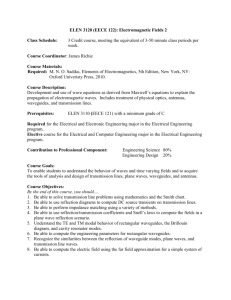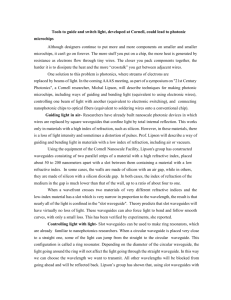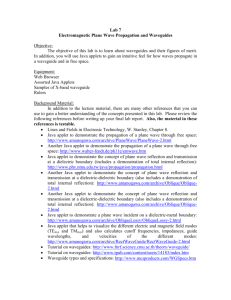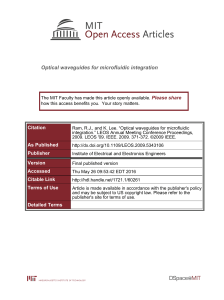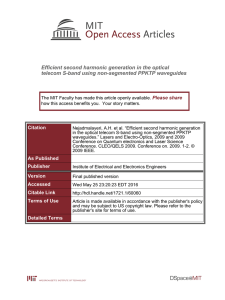18.369 Midterm Exam (Spring 2012) Problem 2: Symmetry (30 points)
advertisement
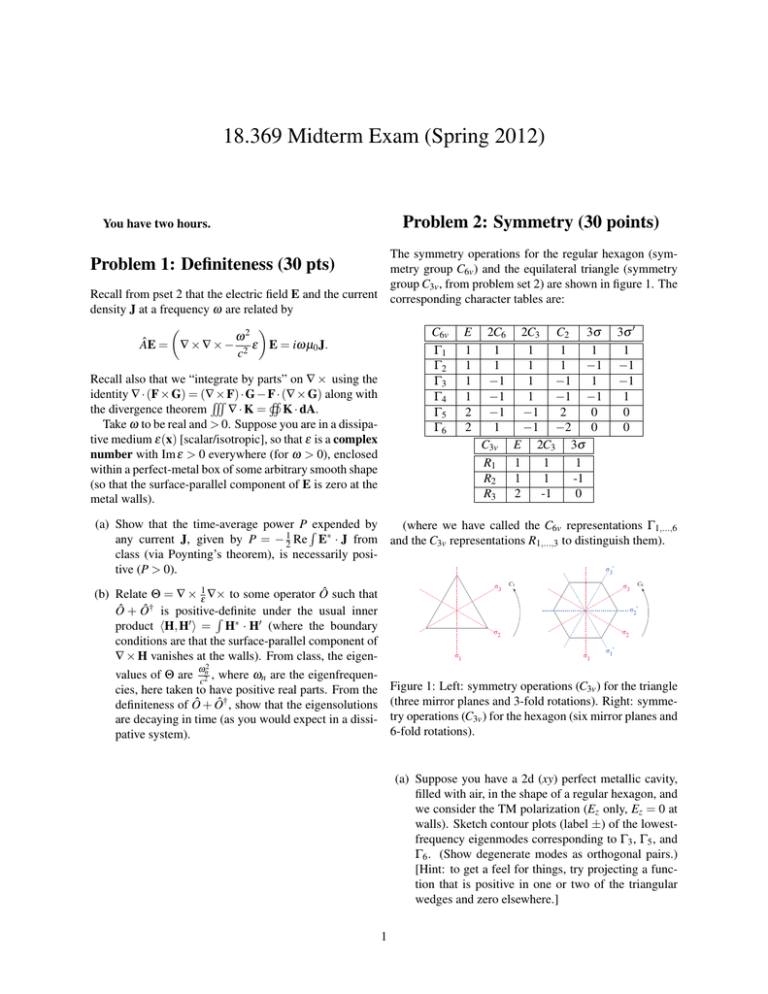
18.369 Midterm Exam (Spring 2012) Problem 2: Symmetry (30 points) You have two hours. The symmetry operations for the regular hexagon (symmetry group C6v ) and the equilateral triangle (symmetry group C3v , from problem set 2) are shown in figure 1. The Recall from pset 2 that the electric field E and the current corresponding character tables are: density J at a frequency ω are related by C6v E 2C6 2C3 C2 3σ 3σ 0 ω2 ÂE = ∇ × ∇ × − 2 ε E = iω µ0 J. Γ1 1 1 1 1 1 1 c Γ2 1 1 1 1 −1 −1 Recall also that we “integrate by parts” on ∇ × using the Γ3 1 −1 1 −1 1 −1 identity ∇ · (F × G) = (∇˝ × F) · G − F‚· (∇ × G) along with Γ4 1 −1 1 −1 −1 1 the divergence theorem ∇ · K = K · dA. Γ5 2 −1 −1 2 0 0 Take ω to be real and > 0. Suppose you are in a dissipaΓ6 2 1 −1 −2 0 0 tive medium ε(x) [scalar/isotropic], so that ε is a complex C3v E 2C3 3σ number with Im ε > 0 everywhere (for ω > 0), enclosed R1 1 1 1 within a perfect-metal box of some arbitrary smooth shape R 1 1 -1 2 (so that the surface-parallel component of E is zero at the R3 2 -1 0 metal walls). Problem 1: Definiteness (30 pts) (a) Show that the time-average power P ´expended by (where we have called the C6v representations Γ1,...,6 any current J, given by P = − 21 Re E∗ · J from and the C3v representations R1,...,3 to distinguish them). class (via Poynting’s theorem), is necessarily posiσ3' tive (P > 0). σ3 (b) Relate Θ = ∇ × ε1 ∇× to some operator Ô such that Ô + Ô† is positive-definite under the usual inner ´ product hH, H0 i = H∗ · H0 (where the boundary conditions are that the surface-parallel component of ∇ × H vanishes at the walls). From class, the eigen2 values of Θ are ωc2n , where ωn are the eigenfrequencies, here taken to have positive real parts. From the definiteness of Ô + Ô† , show that the eigensolutions are decaying in time (as you would expect in a dissipative system). C3 C6 σ3 σ σ σ2 σ1 σ1 2 ' 2 σ1' Figure 1: Left: symmetry operations (C3v ) for the triangle (three mirror planes and 3-fold rotations). Right: symmetry operations (C3v ) for the hexagon (six mirror planes and 6-fold rotations). (a) Suppose you have a 2d (xy) perfect metallic cavity, filled with air, in the shape of a regular hexagon, and we consider the TM polarization (Ez only, Ez = 0 at walls). Sketch contour plots (label ±) of the lowestfrequency eigenmodes corresponding to Γ3 , Γ5 , and Γ6 . (Show degenerate modes as orthogonal pairs.) [Hint: to get a feel for things, try projecting a function that is positive in one or two of the triangular wedges and zero elsewhere.] 1 frequency (b) Suppose that we have an infinite metal plate (lying in the xy plane with some finite thickness in z) suspended in air, with a hole punched through it. The hole is in the shape of an equilateral triangle, with one side of the triangle falling on the x axis. We now shine a normal-incident planewave (propagating in the +z direction) at the plate, polarized with its electric field in the ±x direction. If we decompose (Fourier transform) the transmitted wave (propagating in the air on the other side of the plate) into planewaves, some portion will be a planewave propagating in the +z direction. Explain why this forwardtransmitted wave must be polarized in the ±x direction. light cone 2 1 k Figure 2: Dispersion relations ω(k) of fundamental modes of two different waveguides 1 and 2, both in air (hence, same light cone ω ≥ c|k|). Problem 3: Bands (30 points) waveguide 2 Suppose that we have two dielectric waveguides 1 and 2 in air, in two dimensions for the TM polarization, with different widths so that their band diagrams are slightly different: the dispersion relations ω(k) of the fundamental modes of both waveguides are shown in figure 2. a waveguide 1 Figure 3: Two different waveguides 1 and 2 alongside one another, between which we put a sequence of small dielectric posts with period a. Assume that the waveguides are far enough apart, and the posts are small enough, that the waveguide eigenfunctions are only weakly perturbed. (a) Suppose that both waveguides are made of the same material εhi but have different widths w1 and w2 . From the band diagram, which of w1 and w2 is bigger? (b) Suppose that we put the two waveguides alongside one another (but far enough apart that their modes only slightly overlap). In between them, we put a sequence of small dielectric posts with period a, as shown in figure 3. Assume that the waveguides are far enough apart, and the posts are small enough, that the waveguide eigenfunctions are only weakly perturbed from those of the isolated waveguides. If we start with the fundamental mode propagating in waveguide 1 at a frequency ω0 , and after propagating for some distance we observe that much of the energy is now propagating in waveguide 2 (in the same direction), what can you say about the period a? (Relate a to some k0 s that you label schematically in the band diagram.) band diagram should look like for k ∈ [0, π/a] (label ω0 , and label corresponding points in figure 2 and your new band diagram with A, B, C, ... as needed to make the quantitative relationships clear). It might be clearer to do this in two steps: first plot the “folded” band diagram for a period a but assuming the waveguides are infinitely far apart and the posts are infinitesimal (i.e. no perturbation to the solutions, just a relabeling), and then plot what happens for a finite separation with finite-size posts. (c) Suppose that you have the same situation as in the previous part, but now you want to start in waveguide 1 at ω0 and end up in waveguide 2 propagating in the opposite direction. What would you choose a to be (again in terms of labelled k’s)? (If there is more than one possible a, give the smallest choice.) (d) If you calculated the band diagram for this whole structure (i.e. both waveguides + posts) together in MPB, with the a from part (c), sketch what the 2






